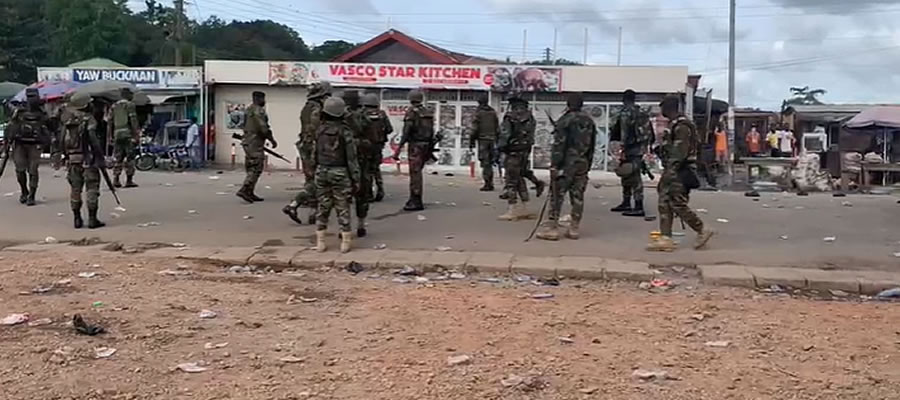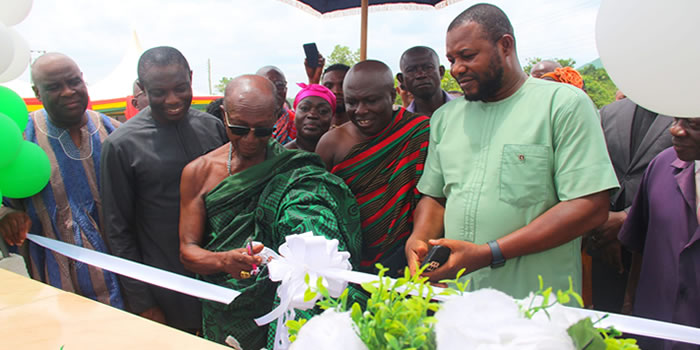

Obuasi Malaria Control Programme
It became evident that malaria was the most significant Public health threat to the community and also threatened the operations of AGA. To deal with this AngloGold and Obuasi Municipal Assembly undertook to implement an Integrated Malaria Control Programme, focussing on Indoor Residual Spraying (IRS) in the Obuasi area.
The programme covered the entire Municipality. The total number of dwellings in the intervention area was 35000.
Malaria is the major health concern in the Obuasi municipality. In 2005, an average of 12,000 cases of malaria was recorded monthly within the Obuasi Municipal Assembly area. Forty-eight (48) percent of all Out Patient Attendants were due to malaria and the disease headed the top ten killers, being responsible for 22% of all deaths (GHS-District Annual Report, 2005).
Obuasi Mine Hospital (Edwin Cade)
Historically (prior to 2006) the Obuasi Mine hospital saw on average 6800 malaria patients per month of a workforce of 8000 + dependents. Of these 2500 are mine employees. With an average of three days off per patient it equates to 7500 man shifts lost per month.
This coupled with the slow work rate during recuperation, results in a major loss in production. Medication for the treatment of malaria was in excess of USD $55 500.00 per month
September 2007 Update On Success of Obuasi Malaria Control Programme
The Indoor Residual Spraying (IRS) component of the Obuasi Integrated Malaria Control Programme commenced in February 2006 with 116 spray men split into 7 Groups. The Information, Education and Communication (IEC) programme conducted by the malaria Community Liaison section had been active in the community for the previous 6 months, informing the community of the means of malaria transmission, what they could do to prevent the spread of malaria and to explain and sensitize them to the impending IRS programme.
Awards
A commendation for the Obuasi Programme was awarded to AngloGold Ashanti at the Global Business Coalitions award ceremony in New York recently
Results
Within the first spray round, a major impact was noted at the mine hospital, a corresponding decline was recorded by the government and private clinics in the area. To date a 73% reduction has been achieved.
This decrease has been maintained by subsequent spray rounds, and it is anticipated that the cases will stabilise at 2000 per month. Fluctuations are a result of:
* In Nov 2006, attendance by 1800 people to a funeral outside the intervention area – 700 contracted malaria (symptoms show 13 days after the event).
* June / July - students returning from University and boarding schools for the holidays.
USD$
2005 - Average monthly cost 55 000.00
2006 - Average Monthly cost (from April) 26 000.00
2007 - Average monthly cost 15 000.00
Lost man days due to malaria
2005 - Average monthly 7203
2006 - Average Monthly (from April) 4423
2007 - Average monthly 2465
Summary
The IRS had a significant and dramatic impact on the incidence of malaria in the Obuasi region. Community members interviewed said that their children were not getting malaria. The number of cases reduced had a notable affect on the hospital as it amounted to 200 patients a day less, the doctors said this reduction in patient load gave them more time for other ailments and the nursing staff remarked on the emptiness the wards (especially the children’s ward).
Once again it must be stated that the phenomenal success of the IRS can be attributed to an effective Community Liaison section who were in tune with the community and were dedicated in spreading the word; the dedication and training of the spray men, efficient supervision and management, correct equipment and vehicles maintained in good order, correct insecticide applied effectively and most of all proper planning and monitoring.
The Obuasi Model has been used as the basis of the Ghana Governments proposal for Round 7 Funding from the Global Fund to implement a IRS based malaria Control programme in 50 districts throughout Ghana ($ 75 million over 5 years) The success of the Obuasi programme has shown the effectiveness and high impact an IRS programme can have on malaria in the country.
Obuasi Municipal Assembly HIV/AIDS Situation Analysis
Over the years the incidence of HIV/AIDS has decreased steadily in the Municipality. The response to HIV/AIDS was initially characterized by a medical approach in which the disease was managed as a health rather than a developmental issue and consequently directed by the Ministry of Health (MOH). However the approach changed to multi sectorial approach.
In 1997, District Response Initiative Teams were put in place by the Government to co-ordinate all HIV/AIDS related matters or activities countrywide of which Obuasi was not left out. The Multi Sectoral Composition of D R I was to ensure that each and every sector is aware of the pandemic and made an effort in the fight against the killer disease.
- People’s life style and behaviour toward the disease
- Wrong perception about the disease – that Aids is not real
- Care and support for PLWAS
- National strategic Framework policy for workers
- Stigmatization
- Limitation of VCTC in the Municipality and
- Inadequate logistical support for stakeholders.
To be able to fight the menace there are collaborative efforts from the two main hospitals OGA/AGA, NGO’s, and CBO’s and other private sector agencies. The targeted population in the Municipality ranges from school children, to miners, artisans, drivers, the youth and indeed the general public using Audio Visual, Drama, Manual distribution for school children and behaviour change communication (BCC).
There is also care and support, counseling, Food Aid, Nutritional Training in income generating activities, VCT and treatment of opportunistic infections. Capacity building with stakeholders is not encouraging particularly with the CBO’s. Most of the CBO’s lack the staffing and managerial competency. Some do not have offices at all.
HIV/AIDS Major Activities
About Ten (10) major activities are carried out in the municipality among them are:
1. Training of Peer Educators and Health Staffs on Nutrition & HIV/AIDS
2. Public Education, Sensitization of Opinion leaders, Security Services, Miners, Tailors/Dressmakers,Garages,Religious Groups and Schools to adapt safer behaviour
3. Quiz Competition, Kiddafest 2004 and Durbars with 32 schools Traditional Rulers participated
4. HIV/AIDS Campaign and Film Shows/Radio Talk Show
5. Support in Vocational Training
6. Formation of Abstinence Clubs in Second cycle, Tertiary Institutions
7. Celebration of World AIDS Day
8. Clinical Services of (STDs) VCCT
9. Food Relief Assistance – Catholic Relief Services
10. MRMT Task Force to Monitor the activities of CBOs/NGO’s in the area.
Orphans and Vulnerable Children (OVC) of HIV/AIDS
One Hundred and Fifty (150) OVCs have been registered- Eighty Two (82) are being supported as against Sixty Eight (68) in the year 2003.
Types Of Support Include
- Health Care
- Education
- Shelter/Clothing
- Vocation/Income Generating Activities, Batik,Sewing,Soap Making, Pomade and Powder Making
- End of Year Party for OVCs and PLWAS.
Age Distribution of Aids Cases
Desegregation of the data by age in both Rural and Urban Surveillance Sites reveals high prevalence among the middle age group i.e. 30 – 39 years and low 60+.
Mutual Health
Achievements
1. The scheme was formally launched in July, 2005 and access to free quality health care became a reality in the municipality in September, 2005.
2. As part of activities to improve service to clients in the municipality the management introduced pay points at vantage points in the municipality to aid registration. It has created permanent job for 15 people.
3. Maturity period has reduced from six months to a maximum of six weeks.
4. Increase in premium collection. That is from an average contribution of ¢53,749,000.00 per month in 2006 to ¢177,973,111.00 per month in 2007. The scheme has increased its premium collection to about 331% a performance worth mentioning.
5. Form a beginning of just four facilities for provision of health care, the scheme now boast of 16 health facilities which are mostly private owned. An achievement which is in line with the government’s policy of enhancing the private sector development.
6. ID cards production has increased over the years. In 2005, 4,032 cards were produced and in 2006, 37,514 cards were produced while as at October, 2007, 43,824 cards has been produced.
7. Relocation of schemes office to ease congestion by the Assembly.
8. Increase in sensitization programmes such as using OPD plat forms.
9. A sign of relief to clients as huge medical bills are taken over by the scheme as in the case of Madam Mary Awuah of Odumasi who spent six months in Komfo Anokye Teaching Hospital and underwent a surgery. Photograph of the woman is attached.
10. Allocation of a Toyota Hillux double cabin from the National Secretariat.
Date Created : 11/27/2017 7:26:46 AM













 facebook
facebook
 twitter
twitter
 Youtube
Youtube
 +233 593 831 280
+233 593 831 280 0800 430 430
0800 430 430 GPS: GE-231-4383
GPS: GE-231-4383 info@ghanadistricts.com
info@ghanadistricts.com Box GP1044, Accra, Ghana
Box GP1044, Accra, Ghana